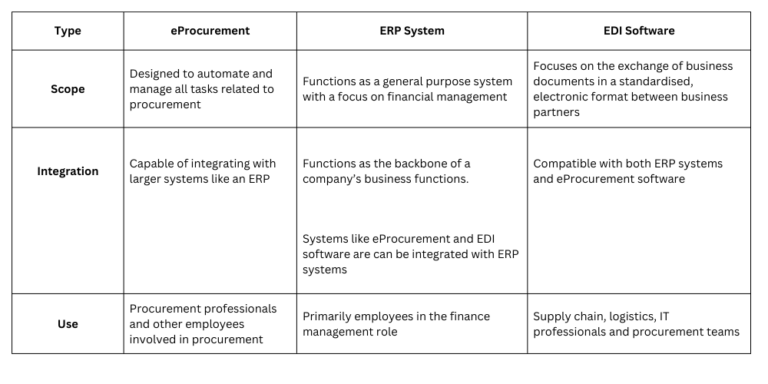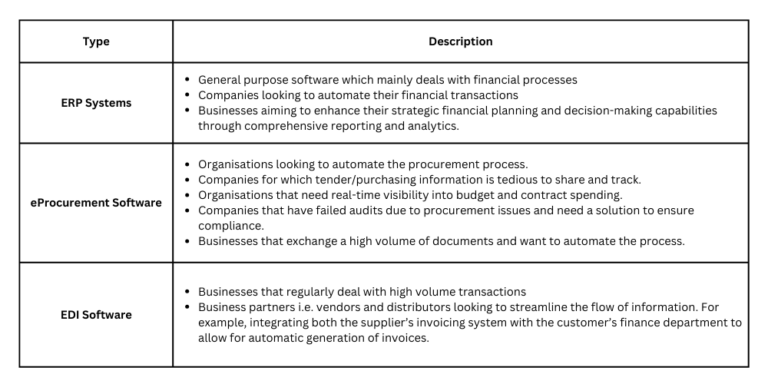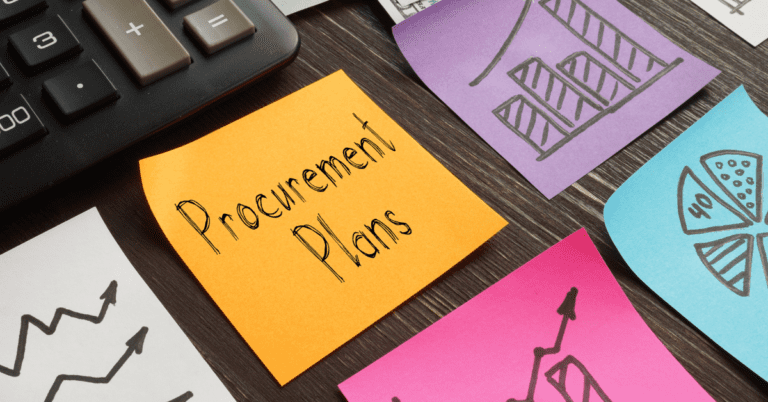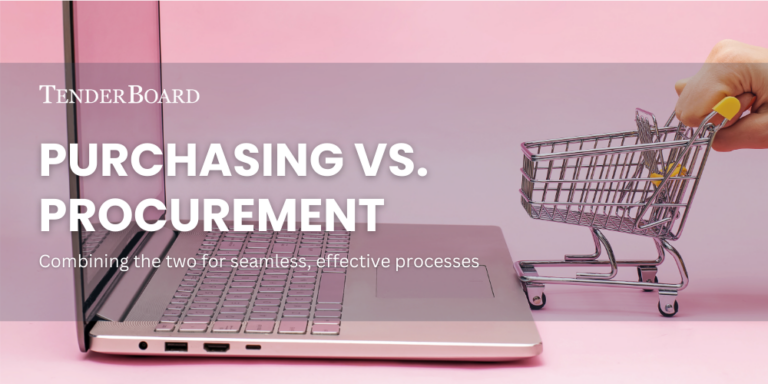Procurement software is one of the most useful tools available to modern businesses, offering significant flexibility and adaptability to suit a variety of organisational needs.
They can be used independently or in combination with ERP and finance systems to cater to the dynamic demands of today’s market landscape.
However, with so many types of procurement systems available, trying to find the right one can get confusing. With that in mind, we’ve prepared this guide which helps you make sense of it all.
Let’s first get started with:
Types of Procurement Software
eProcurement software
eProcurement software is a digital solution that automates the procurement process within a business. It facilitates buying and selling products and services through internet-based applications and platforms.
This software digitalises the source-to-pay process, with various additional functions such as supplier management, purchase order automation, spend analytics, and contract management, among others.
Capabilities & uses of eProcurement Software
Supplier Sourcing: eProcurement software assists in identifying, evaluating, and selecting potential suppliers to ensure that they meet the company’s requirements for quality, cost, and reliability.
Supplier Management: The software helps in managing the entire supplier lifecycle from onboarding to evaluation and performance tracking.
Request for quotation/Tenders: eProcurement software streamlines supplier management, sourcing, and the tender process by automating tasks like vendor comparison, bid evaluation, and performance tracking thereby enhancing transparency and efficiency throughout the procurement lifecycle.
Purchase Requisition and Purchase Orders: It automates the process of creating, approving, and tracking purchase requisitions and orders.
Invoice Management: eProcurement software can facilitate the matching of invoices, purchase orders, and receipts, making the process faster and more accurate.
Contract Management: Centralised contract management with ability to share contracts with
users to encourage utilisation
Compliance: It ensures regulatory and policy compliance by establishing predefined approval workflows and spend limits.
Spend Analysis: eProcurement software provides real-time visibility into spending patterns, allowing organisations to monitor and control expenditure more effectively.
Enterprise resource planning (ERP) systems
An Enterprise Resource Planning (ERP) system is a comprehensive software platform used by businesses to integrate and manage their key functions such as finance, supply chain, operations, reporting, manufacturing, human resources, and more.
These systems essentially serve as the central nervous system of business operations, housing all critical data in a single database to provide business leaders with a holistic view of their organisation’s performance.
Capabilities & uses of ERP systems
Finance and Accounting: ERP systems manage all financial transactions, including accounts payable, accounts receivable, budgeting, and risk management.
Supply Chain Management: They help in managing procurement, order processing, inventory tracking, and supplier relationships.
Human Resources: ERP systems support HR functions like recruitment, onboarding, payroll, talent management, and benefits administration.
Customer Relationship Management (CRM): These systems can track sales, customer interactions, and market trends, enhancing customer service and boosting sales effectiveness.
Business Intelligence: ERP systems offer comprehensive reporting and analytics tools to enable strategic planning and decision-making.
Project Management: An ERP system provides tools to plan, execute, and monitor projects effectively.
Electronic data interchange (EDI) software
Electronic Data Interchange (EDI) software is a technology that enables the exchange of business documents between companies in a standardised electronic format.
This can include invoices, purchase orders, shipment documents, and many other types of business documents. EDI replaces the manual processes of mailing, faxing, or emailing documents.
Unlike true eProcurement systems EDIs only facilitates the sharing of procurement data and lacks supplier or contract management capabilities. Because of this, these types of systems are not considered as actual eProcurement systems.
Capabilities & uses of EDI Software
Document Exchange: EDI software supports the exchange of various types of business documents, such as invoices, purchase orders, acknowledgments, advance ship notices, and many more.
Data Mapping: It can translate business documents into a standardised format that can be read and processed by different EDI systems.
Integration: EDI software integrates with other business systems like ERP, CRM, and accounting software, enabling automated data exchange between systems.
Validation: It can validate incoming data to ensure it complies with business rules and standards.
Audit Trails and Reporting: EDI software offers traceability of transactions, allowing businesses to track, manage, and report on their EDI activities.
Key differences between the 3 types of systems

Who should invest in eProcurement software?

Conclusion
The main benefit of procurement software lies in the flexibility that they offer. Depending on your organisation’s needs, these systems can be used individually or in combination with one another.
For example, TenderBoard’s eProcurement software is easily integrated with a variety of ERP systems. That way, procurement professionals can change up their software configurations to meet the needs of tomorrow’s demanding marketplace.
By implementing tech solutions that allow for automation and smoother communications, businesses can streamline their procurement processes and improve efficiency. All of which contributes to greater profitability and competitiveness.
For more information on eProcurement software solutions, check out TenderBoard’s range of offerings here – www.tenderboard.biz













